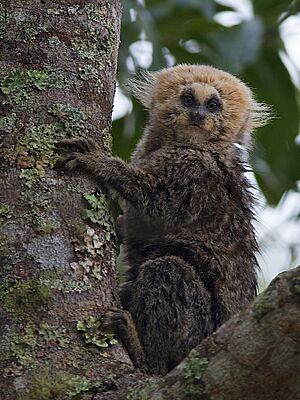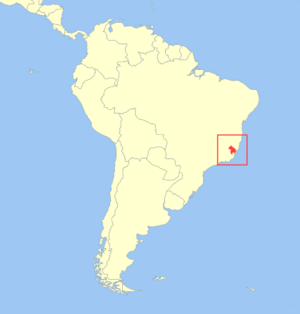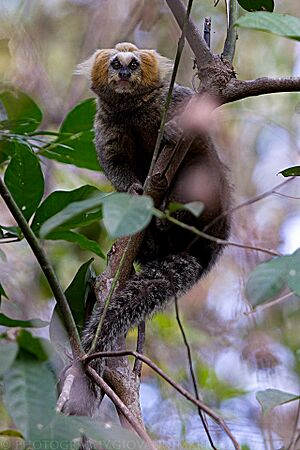Buffy-headed marmoset facts for kids
Quick facts for kids Buffy-headed marmoset |
|
|---|---|
 |
|
| Conservation status | |
| Scientific classification | |
| Genus: |
Callithrix
|
| Species: |
flaviceps
|
 |
|
| Geographic range | |
| Synonyms | |
|
|
The buffy-headed marmoset (Callithrix flaviceps) is a very rare type of marmoset. It lives only in the rainforests of south-eastern Brazil. You can find them in southern Espírito Santo and possibly northern Rio de Janeiro. Their home also reaches into Minas Gerais.
Contents
About the Buffy-Headed Marmoset
Adult buffy-headed marmosets are quite small. They usually weigh between 119 grams and 710 grams. That's about as much as a small can of soda to a large water bottle!
These marmosets have a special way their bodies work. This helps them eat foods that are high in fiber.
Life in the Wild: Behavior and Diet
Staying Safe from Predators
Because they are small, buffy-headed marmosets have many natural enemies. These include big cats like ocelots, large snakes like anacondas, and birds of prey like hawks. Even toucans can sometimes hunt them.
Buffy-headed marmosets have clever ways to avoid danger. They use different alarm calls depending on the threat.
- Dealing with Air Threats (Low Danger): If a bird of prey is far away, they make soft, quiet whistles. This warns others without drawing attention.
- Dealing with Air Threats (High Danger): If a hawk is very close, they make a louder, open-mouthed whistle. This tells everyone to quickly hide under branches or stop moving. Sometimes, they even jump up to 10 meters down from trees to escape!
- Dealing with Ground Threats (Low Danger): For threats like snakes, a few marmosets will call out. Then, the group will gather together. They make low calls to try and scare the predator away. They keep a safe distance, about 15-20 meters away.
- Dealing with Ground Threats (High Danger): If the danger is bigger, like a tayra (a type of weasel), the marmosets gather in a large group. They make very loud, piercing yelps. This loud noise helps to scare the predator away.
Talking to Each Other
Buffy-headed marmosets use different sounds to communicate. They have short-distance calls for talking within their own group. They use loud, shrill, long-distance calls to talk to other marmoset groups.
When an adult finds food, it makes a special call. Younger marmosets and the main female get excited and run towards the caller. If they don't get food right away, they stay nearby. They make small sounds to show they are still there and want some food.
What They Eat
The buffy-headed marmoset mainly eats fruits, tree sap (called gum), and other plant juices. They also eat a small amount of bird eggs and baby birds.
While many marmosets are known for eating a lot of gum, the buffy-headed marmoset mostly eats fungi (like mushrooms) and insects. They hunt for insects like grasshoppers, stick insects, beetles, caterpillars, and even tree frogs.
Fungi: A Favorite Food
Fungi are an important part of their diet. These are often found near bamboo plants. Since fungi are common where these marmosets live, they are a steady food source all year. Fruits and plant juices are not always available. Fungi are usually preferred by the marmosets and are likely very nutritious for them.
See also
- Feliciano Miguel Abdala Private Natural Heritage Reserve



